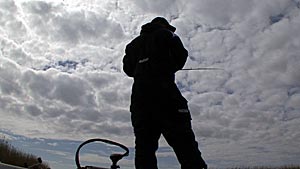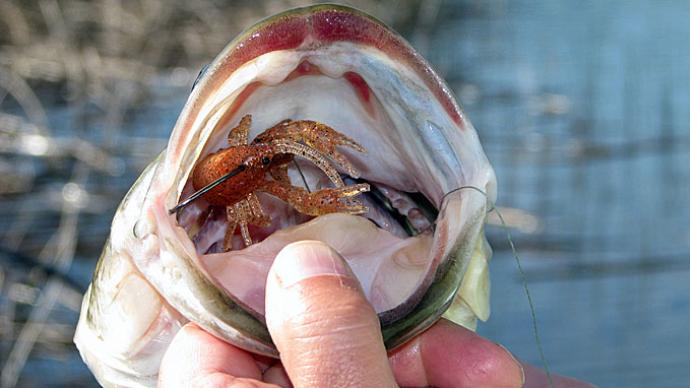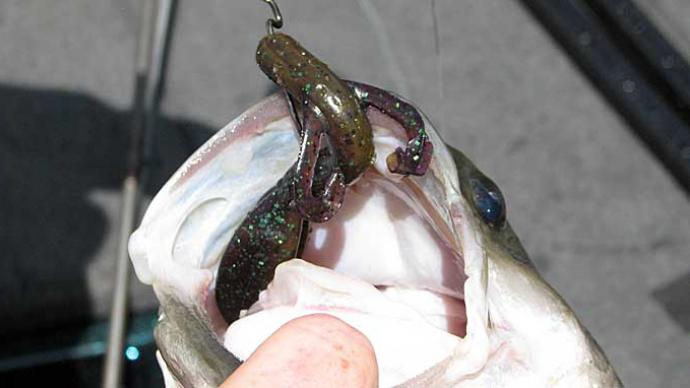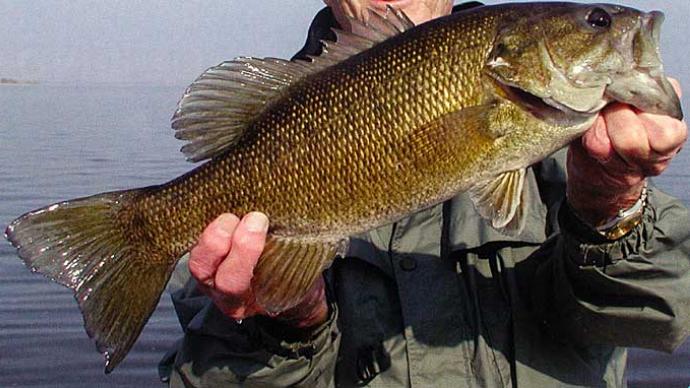
There are several concepts as to what triggers the tendency of bass to make major movements in the fall, but I have always considered two major players.
The first factor is independent of all the others and this is simply the shortening of daylight periods. The second and more variable aspects are the cooling effects of the first major frontal passages and particularly the effect that cool nights or rain associated with cold fronts may have on water temperature.
Most of nature's creatures in the wild tend to become more active feeders in fall in preparation for the approaching winter. Bass are no different. The year's shad crop has reached bite-sized stage and this year's hatch of sunfish has not only grown, but are more likely to venture away from shorelines where bass await.
As with the rest of the year, bass will migrate along contour lines and structure when changing locations in a lake. One of the simplest that defines a fall movement is from a main channel to deeper channels or from feeder channels back up in the coves.
Not all bass begin this shift at the same time and certainly not all move the same distance during this period. Two factors govern where you should look for fall bass. The first is concentrations of shad or other baitfish seen on top or on depth finders. The second is structure. Even bass that are shifting from one area to another will do so by moving from one holding area or given type of structure to another.
You've likely read about the pro's style of run and gun fishing. They eliminate a considerable amount of water by rapidly fishing a selected spot then rushing off to another pre-selected target area. You may not choose to zip around the lake, but thinking your way through a modified strategy for working an area this time of year will give you the best options for finding concentrations of bass.
If your are in a creek channel, work progressively shallower bends until you find the magic depth where concentrations of fish are holding. If you are working a large cove, try deeper points then progressively shallow points as you fish up the cove toward the back end.
The depth at which you find fish on a given side of a lake in one cove or a channel often works on similar locations. The same concept can work in vegetation. To bass, these dense fall growths act like shorelines. The fish will migrate along the deeper edges or channels that traverse the vegetation to shallower portions of the area.
As noted, another factor that makes fall fishing superb is that schools of shifting bass are likely to be active feeders.
Since the major food of choice in most lakes during fall are shad and bream, ideal colors for lures are those that mimic the bait. I have emphasized that bass, at some point in the fall, will move to shallower holding areas during the day, but also will tend to shift toward the bank or close by shallow waters for feeding in the evening, at night, and early mornings.
Unlike their reactions just a month or so ago during the summer, the bass tend to stay in these shallower feeding zones longer in the morning and arrive earlier in the afternoon. This means you have a longer period of time to work topwaters. The old standby chugger or a Zara Spook are great fall baits.
If you have a temperature gauge, pay special attention to water temperatures in the late fall. Folks tend to give up on topwaters because there are several crisp days in a row. The environment of the bass is not affected immediately as is our own and some of the best topwater actions I've had came when I had to wear a windbreaker. Also, when thinking of topwater, don't forget buzzbaits. These are real producers in the fall.
Another fall standby is the spinnerbait. One of the reasons this lure, as well as a crankbait, is well matched for fall fishing is that you are usually fishing for aggressive feeders. Unlike when bass are sluggish, you won't have to force them to hit a bait as you do in the colder waters of winter. It won't require a slower vibration spinnerbait so my choice is often a tandem willow leaf that gives excellent vibrations as well as flash at a moderate speed of retrieve.
A lipless crankbait like a Rat-L-Trap or Hot Spot lets you cover considerable water and again, plays well to feeding bass that have an extended strike zone this time of year.
If we buy the concept that in the fall bass are more likely to have a wider strike zone and be more aggressive feeders, then you can also use this to your advantage. This is especially so when using soft plastics. A more rapid stop and start swimming action with a curly-tail lizard or ribbon-tail worm often succeeds as well or better than slower retrieves.
As with any other time of year while you may get strikes with downsized plugs, you stand a better chance of catching larger fish in the fall with larger lures. The logic of this is that most of the forage has matured and if you are aggressively feeding anyway, why take a nibble if you are offered a big bite.
I have emphasized that in the late fall bass tend to shift toward shallower strata, but remember shallow is relative. For bass that have held in 10 to 15 feet all summer, this may eventually be five to 10 feet before they shift back to winter holding areas. The deeper water bass that tend to hold in 20 to 25 feet in summer may therefore shift to only the 15- to 20- foot level. But if you track a school during fall, I guarantee they'll shift. I also assure you that those bass, when on the deeper side of a 25-foot contour, are less likely to be caught than when you find them in 15 to 20 feet.
If you locate fall bass and decipher their pattern you can generally rely on reproducible fishing for several weeks. The sequential shifts are gradual and tend to stabilize until the more frequent severe cold fronts cause winter patterns to occur. The earlier cold fronts signal enough of a change that bass start their fall routine, but remember if these are relatively mild they still impact on feeding patterns.
What this means is that after the immediate frontal passage fish are going to be sluggish, but with mild fronts they rebound after about 24 hours. However, the cold fronts that occur later in the season often carry much more clout and it may take several post frontal days for things to stabilize.
The greater contrast in air masses (fronts) also means the potential for thunderstorms as well as dramatic wind shifts that occur more often as fall progresses. It is also a reasonable safety precaution to have a plan in place should strong winds or a fast moving front passes through while you're on the lake. The water temperature is not as much of an exposure threat, as it will be when mid-winter fronts pass. However, you can still face rough water and the potential for reduced control of your boat.
Remember, in the fall try different depths. But do so with a specific migration scheme in mind that fits the area of the lake you are fishing.




